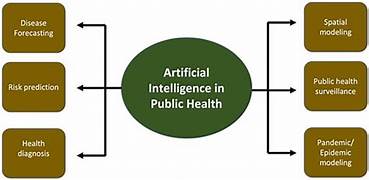The Potential of AI in Improving Public Health Surveillance
Public health surveillance plays a vital role in monitoring, preventing, and managing diseases within populations. It involves collecting, analyzing, and interpreting health-related data to guide decision-making and public health interventions. With the rapid advancement of artificial intelligence (AI), this traditional practice is undergoing a significant transformation. AI’s ability to process vast datasets, identify patterns, and make predictions is unlocking new possibilities for proactive and efficient public health surveillance.
In this article, we will explore the potential of AI in improving public health surveillance, its applications, benefits, challenges, and future implications.
Understanding AI in Public Health Surveillance
Artificial intelligence encompasses a range of technologies, including machine learning, natural language processing, and computer vision, which enable systems to learn from data and make informed decisions. When applied to public health surveillance, AI can analyze diverse data sources—such as electronic health records, social media, environmental sensors, and genomic data—to detect and predict disease outbreaks, monitor health trends, and assess risks.
By automating data analysis and providing actionable insights, AI enhances the speed, accuracy, and scalability of public health surveillance systems.
Applications of AI in Public Health Surveillance
1. Early Detection of Disease Outbreaks
AI systems can analyze real-time data from various sources to detect potential disease outbreaks before they spread widely:
- Social Media Monitoring: Platforms like Twitter and Facebook often contain early indicators of disease outbreaks, such as reports of flu symptoms or food poisoning. AI algorithms can scan social media posts to identify unusual patterns and trends.
- Health Records Analysis: Machine learning models can flag abnormal patterns in hospital and clinic records, such as a sudden rise in patients with similar symptoms.
For example, during the COVID-19 pandemic, AI-powered tools identified clusters of cases early on, helping governments implement timely interventions.
2. Predictive Modeling
AI excels at predictive analytics, enabling public health officials to anticipate future health trends and allocate resources effectively:
- Disease Spread Prediction: AI models can simulate how infectious diseases might spread based on factors like population density, mobility patterns, and vaccination rates.
- Environmental Factors Analysis: AI can correlate environmental data—such as temperature, air quality, and water contamination—with health outcomes to predict outbreaks of diseases like malaria or cholera.
3. Monitoring Chronic Disease Trends
Chronic conditions, such as diabetes and heart disease, require continuous monitoring to identify trends and inform prevention strategies. AI can:
- Analyze population health data to detect rising rates of chronic illnesses.
- Identify high-risk individuals and recommend targeted interventions.
4. Sentiment and Behavioral Analysis
AI-driven natural language processing can analyze public sentiment and behavior regarding health issues:
- Vaccine Hesitancy: AI can monitor online discussions to gauge public attitudes toward vaccination campaigns and identify areas needing focused awareness efforts.
- Behavioral Trends: Analysis of wearable device data can reveal patterns in physical activity, sleep, and nutrition, aiding public health initiatives.
5. Bio-Surveillance and Genomic Analysis
AI can support bio-surveillance by analyzing genomic data to identify pathogens, track mutations, and understand their spread. For example:
- Pathogen Genomics: AI algorithms can rapidly analyze genetic sequences of viruses to identify new variants and assess their potential impact.
- Drug Resistance Monitoring: AI can help track antimicrobial resistance trends, guiding the development of new treatments and policies.
Benefits of AI in Public Health Surveillance
1. Speed and Efficiency
AI can process and analyze vast datasets in minutes, significantly reducing the time needed to detect and respond to health threats. This is particularly crucial during pandemics or natural disasters.
2. Enhanced Accuracy
By reducing human error, AI improves the reliability of data analysis and interpretation. Machine learning models can identify patterns that may be missed by traditional methods.
3. Scalability
AI systems can handle data from diverse sources and large populations, making them suitable for global health surveillance efforts.
4. Cost-Effectiveness
Automating data collection and analysis reduces the need for manual labor and resources, making public health surveillance more cost-efficient.
5. Proactive Interventions
By predicting potential health crises, AI allows public health agencies to implement preventive measures, saving lives and resources.
Challenges and Ethical Considerations
While AI offers significant advantages, its integration into public health surveillance is not without challenges:
1. Data Privacy and Security
- Collecting and analyzing personal health data raises concerns about privacy and security.
- Governments and organizations must establish strict data protection protocols to maintain public trust.
2. Bias in AI Algorithms
- AI models can inherit biases from the data they are trained on, leading to unequal outcomes. For example, underrepresentation of certain demographics in training datasets may result in inaccurate predictions for those groups.
3. Interoperability
- Integrating AI systems with existing public health infrastructure can be technically complex, requiring significant investment and expertise.
4. Ethical Concerns
- The use of AI to monitor behaviors, such as social media activity, raises ethical questions about surveillance and individual autonomy.
5. Access and Equity
- AI technologies may not be accessible to low-resource settings, exacerbating global health inequalities.
Case Studies of AI in Public Health Surveillance
1. BlueDot and COVID-19
BlueDot, an AI-based platform, was among the first to identify the outbreak of COVID-19 in Wuhan, China. By analyzing global airline ticketing data, news reports, and official public health statements, BlueDot provided an early warning about the potential pandemic.
2. Google Flu Trends
Although discontinued, Google Flu Trends demonstrated the potential of AI by using search engine data to track flu outbreaks in real-time. The project highlighted both the promise and limitations of AI, emphasizing the importance of robust data validation.
3. Malaria Prediction in Africa
AI-powered tools are being used to predict malaria outbreaks by analyzing climate data, mosquito population trends, and health records. These predictions enable targeted distribution of bed nets and antimalarial drugs.
The Future of AI in Public Health Surveillance
As AI technologies evolve, their role in public health surveillance will likely expand:
- Integration with Wearable Technology: AI-powered wearables can provide continuous monitoring of individual health metrics, contributing to population-level data.
- Global Health Networks: AI can enable real-time sharing of health data across countries, fostering international collaboration on disease prevention and control.
- Advancements in Natural Language Processing: Improved AI systems will enhance the analysis of unstructured data, such as clinical notes and social media posts.
- Personalized Public Health: AI could help tailor public health interventions to the specific needs of communities and individuals.
Conclusion
The potential of AI in improving public health surveillance is immense. By enabling faster, more accurate, and proactive monitoring of health trends, AI has the power to transform how societies respond to diseases and health crises. However, realizing this potential requires addressing challenges related to data privacy, bias, and accessibility.
With thoughtful implementation and ethical oversight, AI can become an indispensable tool in safeguarding global health, ensuring that public health systems are better equipped to face current and future challenges. As we navigate this exciting frontier, collaboration between technologists, policymakers, and public health experts will be key to harnessing AI’s full potential for the greater good.


